p h o t o g r a p h e r
INTERFACE IMAGES
Photographs by Frankie Quinn
Edited by Frankie Quinn
and Kelvin Boyes
Published by
Belfast Exposed Community Photography Group
The following photographs and extracts have been contributed by the author and photographer Frankie Quinn. The views expressed in these extracts do not necessarily reflect the views of the members of the CAIN Project. The CAIN Project would welcome other material which meets our guidelines for contributions.
 The following photographs and extracts are from the book:
The following photographs and extracts are from the book:
INTERFACE IMAGES
Photographs of the Belfast "Peacelines" by Frankie Quinn
Introduction by Ronana Bennett
Published by Belfast Exposed Community Photography Group, 1994
ISBN 0 9524217 0 4 Softback
Book is now out of print.
This material is copyright Frankie Quinn (1994) and is included on the CAIN site by permission of the author. You may not edit, adapt, or redistribute changed versions of this for other than your personal use without the express written permission of Frankie Quinn . Redistribution for commercial purposes is not permitted.
From Peacelines to Battlelines
In August and September 1969, Loyalist attacks on the Nationalist areas of Belfast sparked deadly communal rioting. Fearful of fresh onslaughts Catholics formed local defence committees and hastily threw up barricades. Although primarily defensive, the barricades were an implicit challenge to the authority of the Stormont government and the Royal Ulster Constabulary. On September 9th, The Unionist Prime Minister, Major Chichester Clarke, insisted the barricades come down, though he conspicuously failed to acknowledge the reason for their construction. When the Catholics failed to comply, their Protestant neighbours retaliated by building their own barricades. Within a few days there were more than two hundred such obstructions in the Lower Falls and Lower Shankill alone. The British Army under pressure from the Stormont Government moved to try to control the communal initiatives by erecting makeshift barriers of barbed wire and sandbags. Lieutenant General Sir Ian Freeland, the then GOC, said, We will not have a Berlin Wall or anything like that in this city and at that time few thought that the army barriers would be in place for long.
But far from being a very temporary affair the peacelines have proved all too durable. They have spread from their original sites along Cupar Way and the Lower Falls, up to Springhill and New Barnsley, Lenadoon and Ladybrook; north to the New Lodge and Tiger Bay, Ardoyne and Oldpark and Cliftonville; and east to Short Strand. As events at Manor Street in 1986 showed, housing redevelopment can often be used to consolidate the peacelines. Also, certain streets that had acted as a buffer-zone for example, Bryson Street in the Short Strand, were demolished and replaced with walls during redevelopment. The temporary peacelines of sandbags and wire are now permanent structures of concrete steel bars and corrugated iron screens.
Belfast, of course has always experienced a high level of segregation. During the late nineteenth century, at a time of industrial growth, rural migrants who flocked to the city in search of work tended to settle in the same areas as their co-religionists. We should not overlook the extent of cross community contact in the workplace, nor the genuine efforts of trade unionists and other progressive forces to unite working-class people in the city, but the problem has always been that at times of political or economic crisis during the riots of 1886, the upheavals following partition in 1921-22, the continuing anti-Catholic disturbance of the 1920s, the severe rioting in 1935 and so on Belfast has tended to divide sharply along sectarian lines.
This tendency was to have devastating consequences for the people in the six counties after the establishment in February 1967 of the Northern Ireland Civil Rights Association. NICRAs demands were moderate; local government reform and an end to discrimination against Catholics in housing and employment. These are objectives that liberal Protestants could and should have supported. Some did notably but most did not, choosing instead to go along with their political leaders characterisation of the Civil Rights marchers as subversives and fellow travellers of the IRA. One of the great what ifs of modern Irish history is; what would have happened if the Civil Rights marchers demands had been met? Would the Northern state have evolved into something more modern and stable, leaving behind the dark days of Stormont discrimination bigotry? Would we have seen the violence of August 1969? Would we have been spared the 3000 plus deaths that have resulted from the war which goes by the euphemism of the Troubles?
There are those on the Nationalist side who argue that the Northern state could never have changed, that for it to do so would have been tantamount to signing its own death warrant, for the state was founded on sectarian principles and had no other rationale than to protect Protestant rule at all costs. After a quarter of a century of conflict, it is hard to take issue with this analysis, Stormont did prove incapable of reforming itself. Instead, Civil Rights marchers were beaten, attacked, intimidated and jailed. The pictures of policemen clubbing demonstrators to the ground in Derry on October 5, 1968 have become almost iconic. For most Civil Rights supporters, they crystallised a moment of stark realisation; nothing was going to change while Stormont remained.
In retrospect, the saddest feature about the period 1967-69 was the failure of the Protestant working-class to make common cause with their Catholic neighbours. As some Protestant leaders now make clear, the Protestant working-class were being taken for a ride by the fur coat brigade, their political leaders in Stormont, at the same time as Catholics were being subjected to discrimination and repression. The privileges the Protestant working class enjoyed better access to (low paid) jobs and (low grade) housing were bought at the expense of uncritical support for political leaders who ignored the needs of their constituents.
Though Civil Rights workers and radical students, in an effort to reach across to the Protestant working-class, stressed the non - sectarian nature of the movement for reform, the sectarian impulse, stoked up by Unionist politicians, proved too strong. Protestant crowds, supported by the sectarian B-Specials, came onto the streets of Belfast, determined to put an end to what they saw as a challenge to their position, their state, their way of life, their religion. The communal rioting of August and September 1969 was the worst for several decades. Eight people died; 1500 Catholic and 300 Protestant families were forced out of their homes. By February 1973, 60,000 people ten percent of the citys population had moved out of their homes in what was, at the time, the biggest population displacement in Europe since World War Two.
The death and destruction was deeply shocking. Since then, of course, the situation has worsened; more than 3000 killings in the Six Counties, almost half of them in Belfast. Half of the Belfast killings (739 at the time of writing) have been classed officially as sectarian; of these by far the largest number of murders (549) has been perpetrated by Loyalist paramilitaries on the Nationalist community; 123 Protestants have been murdered in sectarian killings. Another 155 Catholics and 31 Protestants have been killed by the British Army and RUC.
The 1991 census shows that the trend towards residential segregation proceeds unabated. As the sectarian assassinations continue, it is clear that there is no such thing as a safe area in the city, but it is grimly ironic that among the most dangerous places in Belfast are the areas around the so-called peacelines, as the shooting at Springfield Park/Springmartin earlier this year of Paul Thompson indicates. Here people live in a constant state of anxiety; sectarian tension never goes away. One generation has come to maturity since peacelines first gave physical expression to already existing psychological and instinctive boundaries. A second generation is growing up in conditions even more polarised and divided than those experienced by their parents during their youth. What lies in store for the third generation?
I look at Frankie Quinns photographs and am appalled at the images of urban desolation around the peacelines; and I am appalled at the images of a landscape that reeks of fear and tension and blighted life. But these pictures also provoke anger anger because these peacelines, which are in reality Battlelines, are an enduring symbol of massive failure. The failure is not of the Nationalist community on whom the Troubles are so often blamed, but the British government. The peacelines that British soldiers built and continue to build are the sorry and inevitable outgrowth of a policy, successive British governments pursued since partition; they acquiesced in the creation of the sectarian state; they supported it as long as they could; they continue to underwrite the Unionist veto on the constitutional changes without which sectarianism and segregation will continue to prosper. The peacelines are, in every sense, a British creation. The presence of one is inextricably linked to the presence of the other.
Ronan Bennett
August 1994
Sample Photographs From
'Interface Images'
'Click' on the small images to view a larger version and use your browser's 'back button' to return to this page.
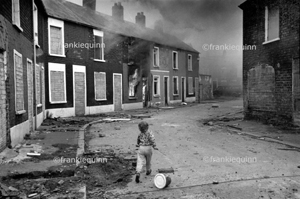 |
 |
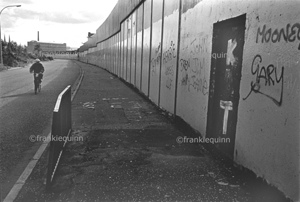 |
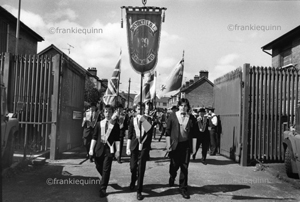 |
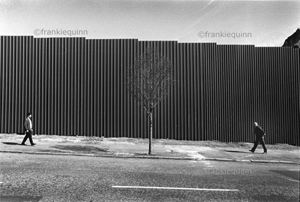 |
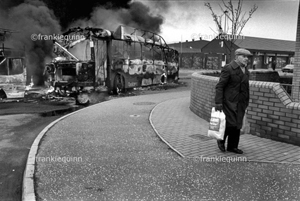 |
Page compiled by Martin Melaugh
Back to the top of this page